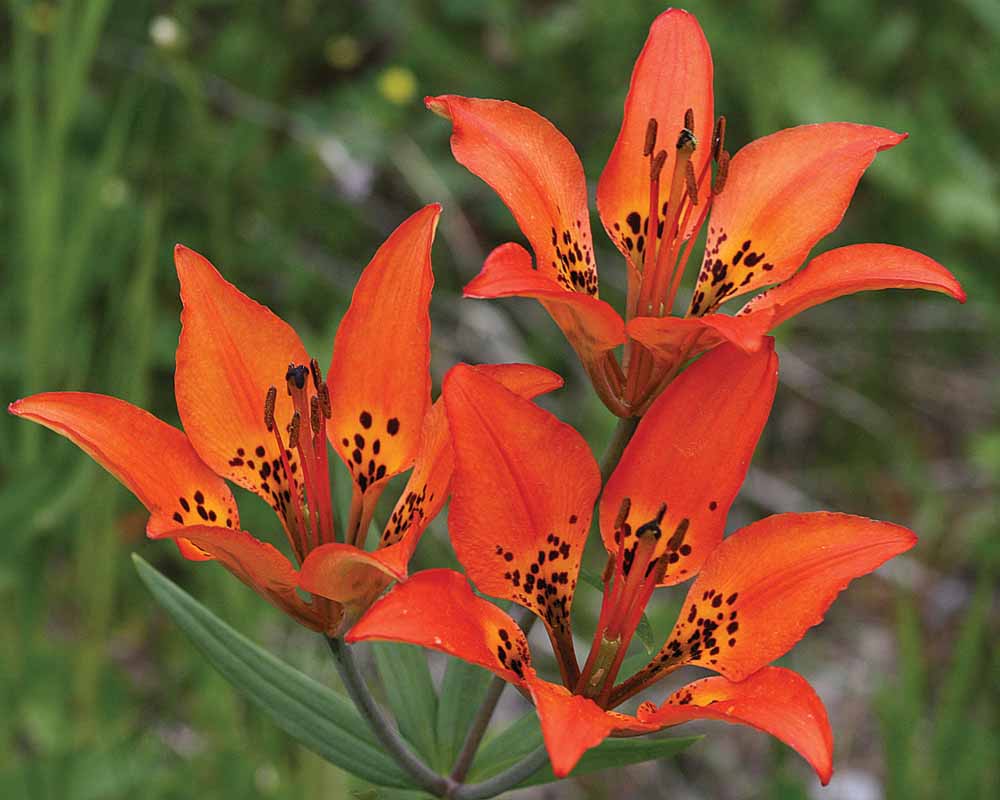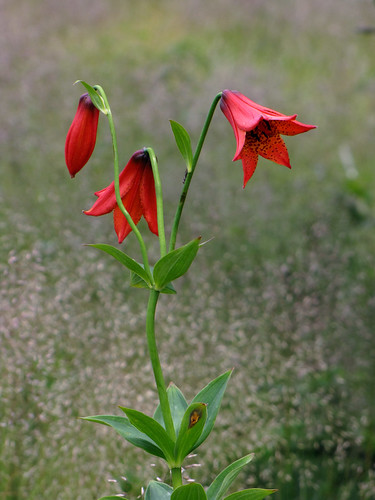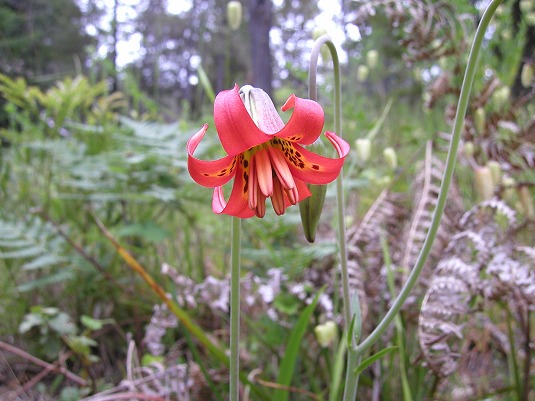Lilium philadelphicum, also known as the wood lily, Philadelphia lily, prairie lily or western red lily, is a perennial species of lily native to North America. It is widely distributed in much of Canada from British Columbia to Quebec, and parts of the United States (Northeast and Great Lakes regions plus the Rocky and Appalachian Mountains).
 This lily grows to a height of approximately 30 to 90 centimeters, and produces red or orange blooms between June and August.
A variant of the species, the western red lily (L. philadelphicum andinum) was designated Saskatchewan's floral emblem in 1941.It is featured on the flag of Saskatchewan.
This lily grows to a height of approximately 30 to 90 centimeters, and produces red or orange blooms between June and August.
A variant of the species, the western red lily (L. philadelphicum andinum) was designated Saskatchewan's floral emblem in 1941.It is featured on the flag of Saskatchewan.
 The wood lily is listed as endangered in Maryland, New Mexico, Tennessee and North Carolina. Its status is "threatened" in Kentucky and Ohio. In Saskatchewan, the flower is protected under the Provincial Emblems and Honours Act, meaning it cannot be picked, uprooted or destroyed in any way.
The wood lily is listed as endangered in Maryland, New Mexico, Tennessee and North Carolina. Its status is "threatened" in Kentucky and Ohio. In Saskatchewan, the flower is protected under the Provincial Emblems and Honours Act, meaning it cannot be picked, uprooted or destroyed in any way.
Lilium grayi (Gray's lily, Orange bell lily, Roan lily) is a perennial plant that is endemic to the Eastern USA states of North Carolina, Virginia, and Tennessee, growing in moist, acid soil in the Appalachian mountains on higher elevation meadows, bogs, and seeps. The plant was introduced to Royal Botanic Gardens, Kew in 1890 and was featured in the Kew Bulletin in 1892.
 The species was named to honor Asa Gray, an eminent American botanist of the mid-19th century who discovered Lilium grayi in 1840 in the Appalachian mountains on Roan Mountain. At the time, Gray wasn't sure that it was a unique species, thinking that it might be a variety of Lilium canadense. He found more plants there in 1879 on a trip with Charles Sprague Sargent. Sereno Watson, curator at the Gray Herbarium of Harvard University, found several differences from Lilium canadense, confirming that it was a distinct species, and named the plant in honor of his colleague.
The species was named to honor Asa Gray, an eminent American botanist of the mid-19th century who discovered Lilium grayi in 1840 in the Appalachian mountains on Roan Mountain. At the time, Gray wasn't sure that it was a unique species, thinking that it might be a variety of Lilium canadense. He found more plants there in 1879 on a trip with Charles Sprague Sargent. Sereno Watson, curator at the Gray Herbarium of Harvard University, found several differences from Lilium canadense, confirming that it was a distinct species, and named the plant in honor of his colleague.
Lilium grayi reaches 2 to 5 ft (0.61 to 1.52 m) tall. The 2 to 3 in (5.1 to 7.6 cm) leaves are lanceolate to oblong-lanceolate and carried around the stem in whorls. The 2.5 in (6.4 cm) reddish-orange bell-shaped flowers bloom in early summer and are carried on several umbels in a tiered style. Sepals and petals have purple spots.
 Lilium grayi is native to mountainous regions in only three U.S. states: North Carolina, Virginia, and Tennessee. It grows in sandstone and acidic soils, meadows, open areas near summits, forest meadows, and bluff outcrops. It grows in full sunlight. Habitat is threatened by overgrazing by cattle, European wild boars, and rabbits. Increase of tree canopy also decreases available open habitat. The plant has also been reduced by illegal collecting and is susceptible to fungal infections.
Lilium grayi is native to mountainous regions in only three U.S. states: North Carolina, Virginia, and Tennessee. It grows in sandstone and acidic soils, meadows, open areas near summits, forest meadows, and bluff outcrops. It grows in full sunlight. Habitat is threatened by overgrazing by cattle, European wild boars, and rabbits. Increase of tree canopy also decreases available open habitat. The plant has also been reduced by illegal collecting and is susceptible to fungal infections.

Lilium canadense, commonly called either the Canada Lily, Wild Yellow-Lily, or the Meadow Lily, is a native of eastern North America. Its native range extends from Ontario to Nova Scotia south to Georgia and Alabama. It is most common in New England, the Appalachian Mountains, and the Canadian Maritimes. It is also cultivated as an ornamental in Europe and other places.
 Flowers emerge in June. They are nodding (hanging downward), yellow, orange or red, often with darker spots. The plant has become less common in urban and suburban areas due to heavy browsing by the white-tailed deer.
Habitat: moist meadows, wood margins • Height: 0.5-1.5 metres
Flower size: 50-75 mm wide
Flower color: yellow, orange, or red
Flowering time: June to July
Origin: native
The flower buds and roots were once gathered and eaten by North American indigenous peoples.
Flowers emerge in June. They are nodding (hanging downward), yellow, orange or red, often with darker spots. The plant has become less common in urban and suburban areas due to heavy browsing by the white-tailed deer.
Habitat: moist meadows, wood margins • Height: 0.5-1.5 metres
Flower size: 50-75 mm wide
Flower color: yellow, orange, or red
Flowering time: June to July
Origin: native
The flower buds and roots were once gathered and eaten by North American indigenous peoples.

Lilium michauxii, commonly known as the Carolina lily can be found in the Southeastern United States from southern Virginia in the north to the Florida Panhandle in the south to eastern Texas in the west. It is most common in July and August but can be found blooming as late as October. It was named for the French botanist André Michaux, who traveled and did extensive research throughout the Southeast.
The common name "Carolina lily" reflects an older taxonomy that used the name Lilium carolinianum for both L. michauxii and L. catesbaei. Another common name, Turk's cap lily, has been listed for L. michauxii, although L. superbum (which is very similar in appearance to L. michauxii) shares this common name.
The C arolina lily can grow to 3½ feet tall with flowers 3–4 inches across. It is the only fragrant lily east of the Rocky Mountains. Its petals bend backward and are spotted. Colors range from yellow through orange to red for background petal color and from red through purple to brown for the spots.
arolina lily can grow to 3½ feet tall with flowers 3–4 inches across. It is the only fragrant lily east of the Rocky Mountains. Its petals bend backward and are spotted. Colors range from yellow through orange to red for background petal color and from red through purple to brown for the spots.
 The Carolina lily is the official state wildflower of North Carolina.
The Carolina lily is the official state wildflower of North Carolina.
Cardiocrinum giganteum, the giant Himalayan lily, is the largest species of any of the lily plants, growing up to 3.5 meters high. It is found in the Himalayas, China and Myanmar (Burma).
The plant was first described scientifically in 1824 by Nathaniel Wallich. The species was introduced into commercial production (as Lilium giganteum) in Britain in the 1850s. A bulb grown from seed collected by Major Madden flowered in Edinburgh in July 1852, while those collected by Thomas Lobb were first exhibited in flower in May 1853.
Cardiocrinum giganteum has been well established in cultivation in England for well over a century.
 Given the rarity of these plants in eastern North American gardens, it's hard to believe, but Peter Hanson grew C. giganteum in Brooklyn, New York, USA during the second half of the nineteenth century. Although originally introduced long ago, C. cordatum and C. cathayanum have only recently become readily available.
Generations of writers have repeated the incorrect notion that these plants are monocarpic. They are not monocarpic. Yes, the flowering stems die after seed set; in fact, they die whether seed is set or not. But so do the fruiting stems of tulips, lilies, fritillaries and a host of other similar plants. The perennial stem (i.e. the basal plate) and its offset bulbs live on from year to year.
A relaxed approach used by Stephen J. Vinisky to germinating seeds is to sow them in a 5 1/2 inch "azalea" pot. He uses a 1/3 grit mixture. The pot size holds about 18 seeds comfortably. After sowing on the surface of the firmed mix, top the seeds with 1/4" of chicken grit. The pots go outside (under the eaves of the house in a shady, eastern exposure to keep off the majority of our almost continuous rain) and are subject to whatever the winter weather provides. In late spring, the seeds put up one very tiny leaf that attracts every slug and snail for miles around. Sluggo is a less toxic way to effectively keep slugs away.
A more active approach is to sow seeds in good potting mix, water and place in a plastic bag at 55-65 °F (13-18 °C) for 2-3 weeks. Then place in the fridge to stratify for 4-6 weeks and return to germination temperature. Remove from the plastic bag and keep the mix moist. Germination can be very slow.
Given the rarity of these plants in eastern North American gardens, it's hard to believe, but Peter Hanson grew C. giganteum in Brooklyn, New York, USA during the second half of the nineteenth century. Although originally introduced long ago, C. cordatum and C. cathayanum have only recently become readily available.
Generations of writers have repeated the incorrect notion that these plants are monocarpic. They are not monocarpic. Yes, the flowering stems die after seed set; in fact, they die whether seed is set or not. But so do the fruiting stems of tulips, lilies, fritillaries and a host of other similar plants. The perennial stem (i.e. the basal plate) and its offset bulbs live on from year to year.
A relaxed approach used by Stephen J. Vinisky to germinating seeds is to sow them in a 5 1/2 inch "azalea" pot. He uses a 1/3 grit mixture. The pot size holds about 18 seeds comfortably. After sowing on the surface of the firmed mix, top the seeds with 1/4" of chicken grit. The pots go outside (under the eaves of the house in a shady, eastern exposure to keep off the majority of our almost continuous rain) and are subject to whatever the winter weather provides. In late spring, the seeds put up one very tiny leaf that attracts every slug and snail for miles around. Sluggo is a less toxic way to effectively keep slugs away.
A more active approach is to sow seeds in good potting mix, water and place in a plastic bag at 55-65 °F (13-18 °C) for 2-3 weeks. Then place in the fridge to stratify for 4-6 weeks and return to germination temperature. Remove from the plastic bag and keep the mix moist. Germination can be very slow.
 Transplant seedlings when they're large enough to handle. Both seedlings and adults should be grown in part sun with plenty of moist and organic rich soils (much like conditions for growing hostas). A little fertilizer is recommended during the growing season.
Transplant seedlings when they're large enough to handle. Both seedlings and adults should be grown in part sun with plenty of moist and organic rich soils (much like conditions for growing hostas). A little fertilizer is recommended during the growing season.
Lilium maritimum is a species of lily known by the common name coast lily. It is endemic to California, where it is known only from the coastline north of San Francisco. It formerly occurred south of San Francisco; these occurrences have all been extirpated. The species is now restricted to the North Coast from Marin County to Del Norte County, and is most common in Mendocino County. It grows in the California coastal prairie habitat, coniferous forests, and bogs amongst Drosera species.
It is also found in scrub, fens, or gaps in the closed-cone forests, usually in low places where it stays wet longer. We have garden plants, but it is found in the wild near us and that is where the first two pictures were taken by Bob Rutemoeller. The next two by Mary Sue Ittner were taken of plants in the road verges. The fifth was taken by Ron Moodycliffe in a paddock near Ft. Bragg, California and the last by Ron Parsons Sonoma County, California. Germination is cool hypogeal, small bulbs are formed in winter and leaves appear in spring.
 Lilium maritimum is a perennial herb usually exceeding a meter in height and known to exceed two meters at times. Specimens from coastal bluffs and similar harsh habitats are much smaller. The plant grows from a scaly, elongated bulb several centimeters long. The oval leaves are mostly basal, with some located in several whorls about the stem. They may reach 18 centimeters long
Lilium maritimum is a perennial herb usually exceeding a meter in height and known to exceed two meters at times. Specimens from coastal bluffs and similar harsh habitats are much smaller. The plant grows from a scaly, elongated bulb several centimeters long. The oval leaves are mostly basal, with some located in several whorls about the stem. They may reach 18 centimeters long
 The inflorescence bears up to 13 large, nodding flowers. The flower is bell-shaped with 6 tepals with tips recurved or curled tightly back. The tepals are up to 5 centimeters long and red to orange, usually with spots. There are 6 stamens with large red anthers sometimes over a centimeter long, and a pistil which may be over 3 centimeters in length.
The inflorescence bears up to 13 large, nodding flowers. The flower is bell-shaped with 6 tepals with tips recurved or curled tightly back. The tepals are up to 5 centimeters long and red to orange, usually with spots. There are 6 stamens with large red anthers sometimes over a centimeter long, and a pistil which may be over 3 centimeters in length.











